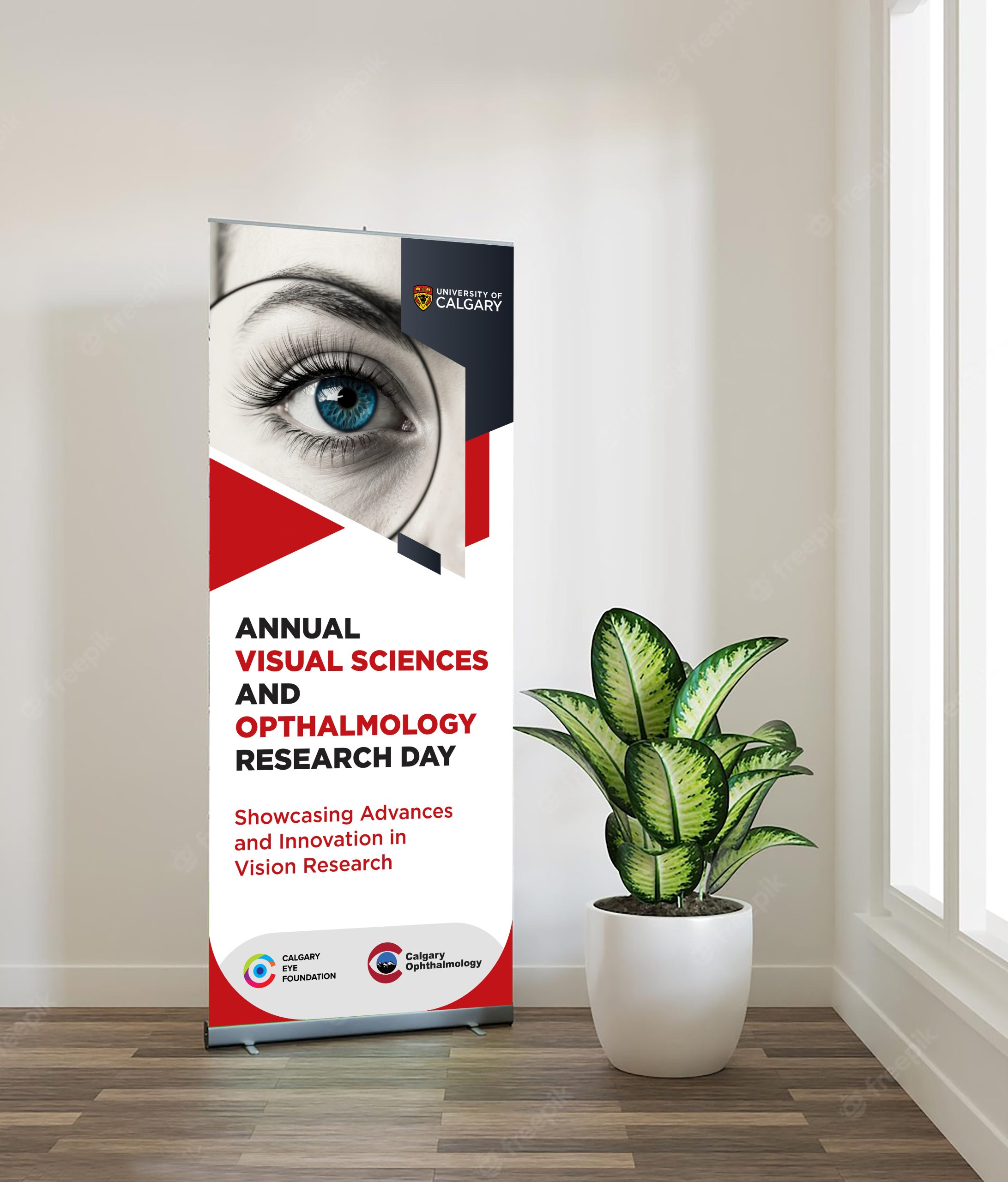Annual Visual Sciences & Ophthalmology Research Day
Thursday, May 29, 2025
The Glencoe Club – DC Ballroom + Club Room A+B
636 29 Ave SW, Calgary, AB T2S 0P1
4:00 PM – 8:15 PM

TABLE OF CONTENTS
A welcoming message
We are delighted to welcome you to the 2025 University of Calgary Visual Sciences and Ophthalmology Research Day. This annual event serves as a unique forum where ophthalmologists, visual scientists, and biomedical engineers come together to share and discuss the latest scientific and clinical innovations in vision science. It is an opportunity to explore emerging ideas from the laboratory, clinic, and operating room and foster collaboration to advance patient care.
This year, we are honoured to host Dr. Edsel Ing from the University of Alberta as our guest speaker. Dr. Ing is a highly respected ophthalmologist, academic leader, and innovator, with over 180 peer-reviewed publications. He currently serves as the Chair of Ophthalmology at the University of Alberta and brings a wealth of clinical, surgical, educational, and leadership experience to our event.
For the 2025 Research Day, we are excited to feature 31 accepted projects, including 13 oral and 18 e-poster presentations. We look forward to your participation in what promises to be an engaging and thought-provoking evening.
In keeping with our commitment to environmentally responsible practices, all posters have been transitioned to an e-poster format, available online at www.UofCResearchDay.com several days before the event. Each e-poster is accompanied by a 2–3-minute video presentation, offering attendees the chance to preview the work and engage in more meaningful discussions during the event.
We extend our sincere gratitude to all presenters for their dedication, creativity, and willingness to share their exciting research. We are also deeply thankful to our panel of judges and session moderators for their valuable contributions in making this event a continued success.
Warm regards,
Dr. Monique Munro – Research Day Director
Dr. Abdullah Al-Ani – Resident Co-Organizer
Program Schedule
- 4:00 – 4:30 PMArrival & E-Poster Viewing
- 4:30 – 4:40 PM Opening Remarks – Dr. Monique Munro
- 4:40 – 4:50 PM Calgary Eye Foundation Representative Remarks
- 4:50 – 5:35 PM Guest Speaker – Dr. Edsel Ing
- 5:40 PM Buffet Opens – served during presentations
- 5:40 – 7:50 PM Oral Presentations
- 7:50 – 8:10 PM Concluding Remarks & Awards Presentation
Guest Speaker:
Dr. Edsel Ing
Chair, Department of Ophthalmology, University of Alberta
Dr. Edsel Ing completed his residency at the University of Toronto, followed by
fellowships in oculoplastics, strabismus, and neuro-ophthalmology at Wills Eye
Hospital, the Mayo Clinic, and Allegheny General Hospital. To promote systems
thinking and leadership in healthcare, he earned a Master of Public Health from
Harvard, a Master of Education from Johns Hopkins, a Master of Business
Administration from Louisiana State University, and a PhD from Kingston University.
Talk Title:
Ab Arena ad Vitrum: A Proletarian Research Journey
Learning Objectives:
1. Organize simple translational research techniques
2. Appraise research findings in ophthalmic safety, oculoplastics, neuro-ophthalmology, and
medical education
3. Encourage curiosity and further discovery

Organizers & Mediators
Dr. Monique Munro (Research Day Director)
Adult & Paediatric Retina and Uveitis Specialist, Section of Ophthalmology, Department of Surgery, University of Calgary
Dr. Monique Munro is a multi-fellowship trained medical retina and surgical retina specialist who subspecializes in uveitis and pediatric retina. Following medical school and ophthalmology residency in Calgary, she went on to complete a medical retina and uveitis fellowship at the Illinois Eye and Ear Infirmary at the University of Illinois at Chicago. She was then accepted for a competitive surgical retina fellowship at this institution. Dr. Munro has been providing care in the Calgary health region since 2022. She serves on Canadian and international ophthalmology committees and avidly participates in research. She loves to travel to local and international conferences to provide the highest quality, up-to-date, evidence-based care for her patients, and will tack on exploring the area for fun. In her spare time, she likes to read, try restaurants, and spend time with her dog, baby, and husband.
Dr. Abdullah Al-Ani (Resident Co-organizer)
Resident Physician, Section of Ophthalmology, Department of Surgery, University of Calgary
Dr. Abdullah Al-Ani completed his undergraduate studies at the University of Victoria, focusing on biochemistry, microbiology, and mathematics. His multidisciplinary interests led him to pursue a PhD in Biomedical Engineering at the University of Calgary, where his research integrated molecular biology, stem cell science, and tissue engineering to develop retinal transplants for degenerative retinal diseases. His doctoral work resulted in several publications and earned multiple prestigious awards, including from the Canadian Institutes of Health Research. He went on to complete the Leaders in Medicine MD-PhD program, graduating with both degrees in 2022, and is currently an ophthalmology resident in Calgary. His long-term goal is to bridge science, engineering, and clinical ophthalmology to drive innovation in eye care. Outside of academia, he enjoys playing soccer, hiking, skiing, and exploring Calgary’s evolving culinary scene.
JUDGES
Dr. Etienne Benard-Seguin
Neuro-Ophthalmologist, Section of Ophthalmology, Department of Surgery, University of Calgary
Dr. Benard-Seguin is a Fellow of the Royal College of Surgeons of Canada (FRCSC) with subspecialisation training in neuro-ophthalmology. Dr. Benard-Seguin received his Bachelor of Science at the University of Ottawa and completed his medical school training at Queen’s University. He then moved west to pursue residency training in ophthalmology at the University of Calgary. He was awarded the prestigious Detweiler Travelling Fellowship from the Royal College of Canada for his neuro-ophthalmology fellowship, which was completed at Emory University in Atlanta, Georgia. Dr. Benard-Seguin is the author of numerous peer-reviewed publications and has received many academic awards. He is excited to be participating as a judge for this year’s research day.
Dr. Ahmed Al-Ghoul
Corneal and Cataract Surgeon, Section of Ophthalmology, Department of Surgery, University of Calgary
Dr. Ahmed Al-Ghoul is a Calgary-based ophthalmic surgeon specializing in cataract and corneal surgery. Originally from Saskatchewan, he completed his medical and ophthalmology training in Saskatoon, followed by a fellowship in cornea and anterior segment surgery at the University of Pittsburgh Medical Center. He holds certifications in both Canada (FRCSC) and the United States (Dip ABO). Since joining Calgary in 2007, Dr. Al-Ghoul has introduced several advanced corneal procedures to the region, including DSAEK, DALK, and Corneal Cross-Linking, and has trained surgeons locally and internationally. He is also one of Canada’s busiest cataract surgeons and a recognized innovator in surgical devices and patient education tools. Dr. Al-Ghoul is actively involved in research and teaching through the University of Calgary, with presentations at major international conferences and multiple awards for his contributions to ophthalmology. Outside of medicine, he enjoys martial arts, hiking in the Rockies, and global travel with his family.
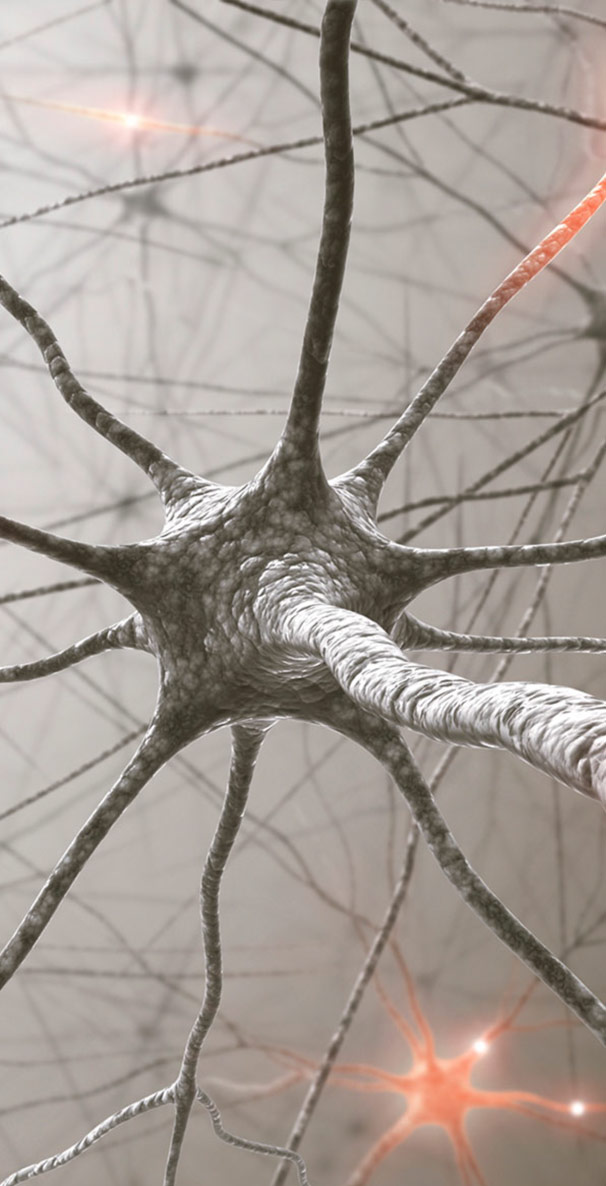
Oral Presentation Schedule
5:40 PM – 7:50 PM | 9 minutes presentation + 1 minute transition
5:40 – 5:50 PM | Spatial and Functional Heterogeneity of Müller Glia Shapes Retinal Microenvironment in Zebrafish - Storey S, Hehr C, McFarlane S
Muller glia are essential support cells in the vertebrate retina and play critical roles in retinal homeostasis and visual function. Notably, zebrafish Muller glia regenerate retinal neurons after injury—a capacity absent in humans. Yet, regeneration represents just one of several Muller glia functions, and recent evidence suggests not all Muller glia equally contribute to this phenotype. Emerging transcriptional data imply Muller glia populations may be functionally specialized, though the nature and significance of this diversity remain unclear.
Methods
We investigated Muller glia functional heterogeneity in the zebrafish retina at three developmental stages (5 days post-fertilization [dpf], 9 dpf, and adult) using single-cell transcriptomics and in situ hybridization.
Results
We identified transient neuronal precursor-like Muller glia subtypes at larval stages, marked by expression of canonical neuronal genes, and find them notably absent in adults. Additionally, distinct Muller glia populations were spatially organized along dorsal, equatorial, and ventral retinal domains, each selectively expressing transcripts involved in retinoic acid (RA) metabolism. Our findings suggest spatially and temporally coordinated RA metabolism orchestrated by distinct Muller glia subpopulations. Further, we observed a correlation between these Muller glia spatial domains and the distribution of photoreceptors specifically adapted to match the larval zebrafish spectral environment. This suggests a potential mechanism by which Muller glia regulate photoreceptor anisomery through localized modulation of the retinal RA microenvironment.
Conclusion
Our findings reveal previously unrecognized spatial and temporal patterns of MG transcriptional diversity that will help identify precise roles and regulatory mechanisms underlying Muller glia functional heterogeneity.
5:50 – 6:00 PM | A Diffusion Model-Based Self-Explainable Generative Classifier for Retinal Image Analysis - Ahsan A, Nielsen C, Forkert N, Wilms M
Vision-influencing ocular conditions, such as diabetic retinopathy, age-related macular degeneration,cataracts, glaucoma, and degenerative myopia, affect millions of patients globally. Early diagnosis and treatment can reduce the impact of those conditions, which can be identified in color fundus photographs (CFPs). However, manual interpretation of CFPs is a time-consuming process that requires visual assessment by an experienced ophthalmologist. Therefore, several deep learning models have been proposed to support automated retinal disease classification from CFPs. While those discriminative classification models usually achieve a high performance, their black-box nature creates challenges when trying to understand their decision-making process, which is crucial to establish trust in their results in a clinical setup.
Methods
To alleviate this problem, this paper introduces the first fully self-explainable generative classifier for the computer-aided diagnosis of multiple ocular conditions from CFPs. More precisely, we propose a generative diffusion model, which is repurposed as a classifier. Contrary to discriminative models, our generative classifier is inherently self-explainable due to its ability to synthesize so-called counterfactual images that can be used to visually highlight alternate classification outcomes.
Results
We train and evaluate the proposed method on more than 25,000 images encompassing five different ocular conditions and achieve a competitive classification accuracy of 97.38%. Moreover, the counterfactual images generated by our model visually confirm that it has learned the hallmark features of the ocular conditions included in the data.
Conclusion
We believe that our self-explainable generative classifier is an important step towards trustworthy AI in ophthalmology as it removes the explainability challenges surrounding standard discriminative classifiers.
6:00 – 6:10 PM | Tear Proteomics and Metabolomics as Sources of Biomarkers Associated with Elevated Intraocular Pressure - Fernandes A, de Almeida L, Young D, Dufour A, Melin A
Purpose
To explore tear proteomic and metabolomic profile differences with respect to naturally-occurring intraocular hypertension (OHT) in free-ranging rhesus macaques (Macaca mulatta)
Methods
We studied 54 macaques (56% females) aged 0.6 to 25.2 years (mean±SD: 13.7±5.2) from the Cayo Santiago colony in Puerto Rico. Individuals underwent a comprehensive eye examination including intraocular pressure (IOP) assessment using a TonoVet tonometer (iCare, Finland). Schirmer Tear Test Strips were used to collect tears (5 μl) from the inferior temporal tear meniscus from both eyes. Proteomic profiles were obtained via liquid chromatography-mass spectrometry (LC-MS), and metabolomic profiles via methanol-water extraction, using global (Agilent Q-TOF-MS) and targeted (Agilent Qtrap LC-MS/MS) profiling. Identified proteins and metabolites were compared across IOP levels (normal:<22mmHg; high:≥22mmHg), adjusting for sex and age.
Results
In eyes with OHT, we observed significantly higher levels of the protein superoxide dismutase (SOD2) and eleven metabolites, including adenosine monophosphate (AMP) and glutamine, compared to normotensive controls. Conversely, seven proteins—such as 6-phosphogluconolactonase, vinculin, Rho GDP-dissociation inhibitor 1, and macrophage migration inhibitory factor—and metabolites like methionine sulfoxide, thiamine, and linolenic acid were downregulated. These changes suggest impaired antioxidant defense (via SOD2 upregulation) and disruptions in Rho GTPase signaling, hemostasis, and energy metabolism, as indicated by Metascape analysis. Notably, AMP—central to energy homeostasis and cellular signaling—was the most upregulated metabolite. Elevated glutamine levels may reflect a neuroprotective response to glutamate-induced toxicity, a known contributor to retinal ganglion cell death in glaucoma.
Conclusion
Tear proteomics and metabolomics offers a promising non-invasive approach for identifying candidate biomarkers associated with elevated IOP. These findings enhance our understanding of molecular mechanisms underlying IOP dysregulation and may contribute to development of early diagnostic tools or therapeutic targets for glaucoma.
6:10 – 6:20 PM | Human and Frog Opsins: What Do They Tell Us About the Evolution of Eye Neuronal Circuitry? - Bertolesi G, Man L, Heshami N, McFarlane S
Since George Wald’s 1955 Nature publication describing visual pigments and Vitamin A in the clawed toed frog (Xenopus laevis), this model organism has advanced our understanding of retinal neuronal circuits and opsins in light detection. Comparing the genomes of humans and Xenopus, we identified 22 opsins in Xenopus compared to 9in humans. While the retinal neuronal circuits in both species are similar, striking differences in opsin types and localization offer new insights. Here, we discuss three opsins we identified and functionally explored in Xenopus, enhancing our understanding of the evolution of light-sensing:
1.Melanopsin, crucial for non-visual tasks like sleep regulation and circadian rhythms in humans, is also expressed in horizontal cells and retinal ganglion cells (RGCs) in Xenopus. The melanopsin-positive horizontal cells are lost in humans but may sense surface light in Xenopus.
2.Neuropsins (Opn6 and Opn7), present in the ciliary marginal zone (CMZ) stem cell niche of Xenopus, may support lifelong photoreceptor generation. Humans lack Opn6/7 and a CMZ, expressing only Opn5, presumably reflecting the evolutionary loss of a light-dependent photoreceptor genesis mechanism likely present in non-mammalian eyes.
3.Pinopsin, we find crucial for light-mediated regulation of circadian behavior by the “third eye” in Xenopus. This structure is absent in mammals, where light-mediated regulation of circadian behavior is the sole responsibility of retinal Melanopsin. The disappearance of pinopsin and the “third eye” during evolution highlights significant functional divergence.
These findings underline how studying Xenopus contributes to our broader understanding of human vision and evolutionary adaptation.
6:20 – 6:30 PM | Refractive Outcomes and Higher-Order Aberrations Following Light-Adjustable Lens Cataract Surgery: A Mixed-Effects Analysis - Sadek K, Maddigan A, Bhamra J
Purpose
To evaluate changes in visual acuity, intraocular pressure (IOP), refractive error, and higher-order aberrations (HOAs) over three postoperative timepoints in eyes implanted with the Light Adjustable Lens (LAL), and to compare these trajectories between dominant (distance-targeted) and non-dominant (near-targeted) eyes. Secondary analyses explored outcomes in eyes with prior refractive surgery, complication events, and varying numbers of light treatments.
Methods
In this retrospective cohort study, 102 eyes from 51 patients undergoing bilateral LAL implantation were analyzed at 2 weeks postoperatively (Week 2), after the second light delivery device treatment (LDD2), and after final lock-in (Lock2). Outcomes included uncorrected visual acuity (UCVA), best-corrected visual acuity (BCVA), IOP, manifest and objective refractive error (Optom_M, Auto_M), and wavefront-derived HOA metrics (total RMS, coma, spherical aberration). Linear mixed-effects models with patient-level random intercepts evaluated the effects of timepoint and eye dominance on outcomes.
Results
UCVA improved significantly across timepoints (Lock2 vs Week 2: ∆=0.042 logMAR, p=0.045), with most eyes achieving 20/20 vision. Auto_M shifted by ∆=−1.13 D (Lock2 vs Week 2, p<0.001), and Optom_M by ∆=−1.02 D (Lock2 vs Week 2, p<0.001), indicating substantial refractive refinement. iTrace total RMS decreased (∆=−1.21 µm, p<0.001), without significant change in specific HOA components. Dominant-eye status influenced baseline refractive metrics (p<0.001) but did not modify postoperative trends.
Conclusions
LAL implantation enables precise postoperative refractive adjustments, resulting in excellent uncorrected vision without significant induction of HOAs. Both distance- and near-targeted eyes achieved intended outcomes. These findings affirm the safety and efficacy of LAL technology; further prospective studies with extended follow-up are warranted.
6:30 – 6:40 PM | Consent for Resident Participation in Pediatric Strabismus Surgery - Waldner D, Rudnisky C, Dotchin S
Informed consent is essential to shared decision-making in healthcare. While resident participation in ophthalmic surgery is common, the effect of disclosure on consent is debated. This study evaluates the proportion of parents consenting to resident participation in their child’s strabismus surgery when fully informed.
Methods
A prospective observational case series included parents of children under 18 undergoing their first strabismus surgery. During the consent process, parents were read a script explaining resident roles: “I have residents that work with me in the operating room. A resident is a medical doctor training to be an ophthalmologist. Some may do very little, like just watch; others might do a lot, like maybe the whole thing. I’m always there supervising and guiding them, and I don’t let anyone do surgery that they can’t actually do. I never leave them alone in the operating room, and am there to guide and assist them so that we function like a team.” At the first post-operative visit, parents were asked to explain their decision to consent or decline.
Results
Preliminary data from 83 parents revealed 89.2% (74/83) consented to resident participation. Themes associated with consent included trust in the primary surgeon, support for education, and personal experience with hands-on learning. Reasons for declining included preference for the experienced surgeon and concerns about surgical intricacy.
Conclusions
Full disclosure of resident participation in pediatric strabismus surgery does not significantly reduce parental consent. Transparent communication may enhance trust while preserving critical training opportunities for residents.
6:40 – 6:50 PM | Investigating the Role of OCT Angiography in Differentiating Choroidal Nevus from Choroidal Ephelis - Pham M, Srivastava O, Crump T, Benjamin G, Weis E
Purpose
Choroidal nevi and ephelides are both pigmented ocular lesions, yet only choroidal nevi havepotential for malignant transformation. Optical coherence tomography angiography (OCTa)provides a non-invasive means to assess the choriocapillaris, the capillary layer of the choroid,which can be disrupted and compromised in space-occupying lesions. Improving lesiondifferentiation with OCTa may optimize surveillance and early detection strategies. The studyaimed to evaluate whether OCTa can differentiate choroidal nevi from ephelides based onchoriocapillaris integrity as represented in the image. We hypothesized that choroidal nevi wouldshow displacement or loss of visible choriocapillaris vessels on OCTa.
Methods
We conducted a prospective case-control study analyzing OCTa images of patients withchoroidal nevi and ephelides from an ophthalmology clinic. The primary outcome was whetherchoriocapillaris vessels were preserved in the affected area. Fisher’s Exact Test was used tocompare choriocapillaris visibility between the two groups.
Results
Forty-nine patient records (choroidal nevi: N=30, ephelides: N=19) were analyzed. Loss ofchoriocapillaris on OCTa was significantly associated with choroidal nevus diagnosis (p<0.005).Test characteristics for choriocapillaris preservation were strong in predicting choroidal ephelisdiagnosis among those with available choriocapillaris data (sensitivity=100.0%,specificity=87.5%, positive predictive value=85.0%, negative predictive value=100.0%).
Conclusion
Our findings suggest that OCTa is a valuable diagnostic tool for distinguishing betweenchoroidal nevi and ephelides based on choriocapillaris visibility. The lack of structuraldisplacement with ephelides results in choriocapillaris preservation. Future research will validatefindings in a larger cohort.
6:50 – 7:00 PM | Stripping Down the OR: A Scoping Review of Evidence-Based and Environmentally Sustainable Practices in Cataract Operating Rooms - Lynton Z*, Al-Ani A*, Rawlyk B, Moore R, Kryshtalskyj M, Klassen T, McClurg C, Gooi P, Huang P. *Equal contribution
Purpose
The clinical benefit of operating room (OR) sterility practices in preventing post-cataract endophthalmitis remains uncertain. Amid growing concerns about the environmental impact of surgical waste, this scoping review evaluates the clinical evidence on OR sterility practices in cataract surgery to identify potentially unnecessary practices that could be targeted for waste reduction.
Methods
A comprehensive search following PRISMA guidelines was conducted across Embase, MEDLINE, Scopus, Web of Science, Cochrane, CINAHL, and ProQuest. Two independent reviewers screened studies for inclusion based on practice patterns, complications, and environmental impacts of antiseptic solutions, drapes, gloves, masks, and gowns in cataract surgery. Meta-analyses were performed where applicable.
Results
Of 3360 articles screened, 140 met inclusion criteria. Included studies comprised 83 (56%) experimental studies (clinical trials, cohort, cross-sectional, and case-control), 10 (7%) case reports/series, 24 (16%) survey or prevalence studies, 25 (17%) opinion-based articles or guidelines, and 6 (4%) economic or environmental evaluations. Meta-analysis of 2,677 eyes demonstrated that conjunctival povidone-iodine significantly reduced post-operative bacterial load (Kruskal-Wallis test and post-hoc Dunn’s tests, p = 0.0025). More studies supported a protective effect of face mask use (n=3) compared to those reporting no effect (n=2). Literature on draping, gloving, and gowning was predominantly opinion-based (39%, 38%, and 55%, respectively), suggesting these practices may be driven more by tradition than evidence.
Conclusion
Many OR sterility practices may not meaningfully impact clinical outcomes, yet contribute substantially to surgical waste. Re-evaluating the necessity of drapes, gowns, and gloves is critical to optimize the balance between patient safety and environmental sustainability.
7:00 – 7:10 PM | Frontalis Muscle Flap Advancement Technique for Blepharoptosis Correction: A Canadian Experience -Punja K, Florido A, Kryshtalskyj M, Schell C
Purpose
To evaluate the surgical outcomes, technical considerations, and complication profile of the frontalis muscle flap advancement (FMFA) technique for severe ptosis in patients with poor or absent levator function.
Methods
This retrospective review includes 34 patients (50 eyelids) from two Canadian centers who underwent FMFA between 2023 and 2025. The cohort comprised 11 adults (16 eyelids) and 23 children (34 eyelids) with severe ptosis and minimal levator function. Etiologies included Oculopharyngeal Muscular Dystrophy, Chronic Progressive External Ophthalmoplegia, myogenic and myotonic dystrophies, and third cranial nerve palsy. The FMFA technique entailed direct advancement of the frontalis muscle to the tarsus, circumventing the need for slings or grafts. Pre- and postoperative margin reflex distance 1 (MRD1) were compared using paired t-tests.
Results
The mean preoperative MRD1 was +0.30 mm (SD ±1.27), increasing to +3.34 mm (SD ±1.24) postoperatively (p<0.001). The maximum MRD1 gain (+7.0 mm) was observed in a 79-year-old with CN3 palsy; the minimum gain (+1.5 mm) was targeted in a patient with CPEO and poor Bell’s phenomenon. Transient lagophthalmos and eyelash inversion occurred in a minority of cases and were managed conservatively. No major complications were reported. At a mean follow-up of 14 months, all patients demonstrated stable, functional, and aesthetically acceptable eyelid positions
Conclusion
FMFA offers a dynamic, graft-free alternative for correcting severe ptosis in patients with nonfunctional levators. Its reproducibility and favourable aesthetic outcomes support its growing role in ptosis repair. Further longitudinal studies are needed to assess durability compared to conventional frontalis suspension techniques.
7:10 – 7:20 PM | One-Year Safety and Efficacy of the Transconjunctival Ab Externo Approach to XEN45 Gel Stent Implantation - Wandzura A, Thatcher M, Rawlyk B, Campos-Baniak M
Purpose
To determine the IOP-lowering effect and safety profile of the transconjunctival ab externo approach to XEN stent implantation in glaucoma patients.
Methods
We conducted a retrospective cohort study. 109 patients receiving transconjunctival ab externo XEN implantation from a single surgeon from 2020-2022 in Saskatoon, Saskatchewan were included. Number of glaucoma medications and intraocular pressure (IOP) were recorded at preoperative 1 day, 1 week, 1- , 3-, 6-, and 12-month postoperative appointments. Primary outcomes were “complete success” defined as IOP ≤18 mmHg and ≥20% baseline reduction at 12- months, without medication. Qualified success was the same, with medication. “Failure” was needing additional surgery, loss of light perception vision, or IOP >18 mmHg or <20% baseline reduction.
Results
Of 109 cases with a postoperative visit at 12-months, complete success was achieved in 33 cases (30.3%) and qualified success was achieved in an additional 16 cases (14.6%). Of the 60 failures (55.0%), 34 cases required additional surgery (23 XEN revisions, 9 Ahmed valves and 2 PRESERFLO™ shunts) and 26 cases did not meet the IOP-lowering criteria for success. We report a cumulative 54% IOP reduction on 0.87 medications at 12 months. Safety was evaluated via adverse event rate (categories: choroidal, infectious, device breakage, other) and was 12.8%.
Conclusions
Transconjunctival ab externo XEN implantation reduced IOP and medication use at 1-year comparable to contemporary literature. Our results suggest that the transconjunctival ab externo approach has comparable safety and efficacy to the ab interno and open conjunctival ab externo approaches to XEN implantation.
7:20 – 7:30 PM | Comparative Evaluation of a Novel Virtual Reality Visual Field Testing Device in Patients with Early Glaucoma - Waldner D, Al-Ani A, Crichton A
To evaluate the performance and accuracy of a novel virtual reality (VR) visual field testing device compared to the gold-standard Humphrey Visual Field (HVF) in detecting early glaucomatous visual field deficits.
Methods
This prospective, cross-sectional comparative study enrolled 49 participants diagnosed with mild glaucoma, defined by a mean deviation (MD) between 0 and -6 dB. Participants had previously undergone comprehensive ophthalmic evaluations and multiple 30-2 HVFs with a reproducible defect. Enrolled patients underwent a 30-2 VF on the RetinaLogik VRVF protocol within a one-month period. Analyses of mean deviation, pattern standard deviation and individual points sensitivities between devices, and also between multiple HVFs for comparison were performed via multiple statistical methods
Results
The RetinaLogik 30-2 VRVF consistently measured higher point sensitivities compared to the 30-2 HVF as evidenced by analyses of mean deviation (Bland-Altman bias +2.2 +/- 1.6 dB), and individual points (Bland-Altman bias +2.25 +/- 5.2 dB). Analysis of each of the 76 points of the 30-2 field identified the nasal periphery as the most likely to have glaucomatous change with both devices, but also the area with the highest discrepancy between devices (µ point difference -4 dB, -6 dB, -6.15 dB and -6.37 dB in nasal-most four points). Similar error was not observed in repeat analysis of HVFs.
Conclusions
RetinaLogik 30-2 VRVFs demonstrated a consistent positive bias compared to the HVFs in evaluation of these patients, compromising the sensitivity of this device with regards to early glaucomatous visual field changes. Future directions include repeat evaluation of the device’s performance with an updated algorithm for peripheral sensitivity.
7:30 – 7:40 PM | VIEWSS – Visual Impairment: Exploring Ways to Improve the Lives of Stroke Survivors Validation of Virtual Reality Automatic Perimetry as an Alternative to the Humphrey Field Analyzer - Sylvestre-Bouchard A, Shi B, Kuhl L, Dukelow S, Costello F
This prospective, single-center, self-controlled, study evaluated the use of a virtual reality (VR) device to assess visual field deficits in stroke survivors by validating its performance against the Humphrey Field Analyzer (HFA) and by gauging patient satisfaction through a survey. First‐time stroke survivors (n=13) underwent the monocular 24-2 SITA Standard and binocular Esterman tests on both devices within a 48-hour period. Each eye’s data was analyzed separately. For the monocular assessment, a (3,1) intraclass correlation test revealed moderate to good pointwise reliability between the VR and HFA devices (left eye: ICC = 0.732, p < .001; right eye: ICC = 0.762, p < .001). Bland–Altman analyses indicated a pointwise bias of –2.40 dB (95% LOA –6.59 to 1.78 dB) for the left eye and –2.29 dB (95% LOA –6.17 to 1.58 dB) for the right eye, suggesting that the VR device detected, on average, approximately 2.3–2.4 dB higher sensitivity than the HFA. Additionally, the SITA Standard test showed significantly shorter test durations and lower fixation losses in both eyes with the VR device compared to the HFA. For the binocular Esterman test, the mean number of targets seen did not differ significantly between devices. However, the VR device produced a significantly higher mean false negative rate and had shorter test durations. Survey responses indicated that 92.31% of participants preferred VR perimetry. The study concluded that VR perimetry has the potential to be a patient-friendly alternative for visual field assessment in stroke survivors, although further investigation is warranted.
7:40 – 7:50 PM | Intravitreal Methotrexate for Proliferative Vitreoretinopathy After RD Repair - Moore R, Al-Ani A, Azarcon C, Kherani S, Williams G, Kherani A
Introduction
Proliferative vitreoretinopathy (PVR) is a leading cause of recurrent retinal detachment (RD) following surgical repair, driven by inflammatory and fibrotic processes on the retinal surface. Methotrexate (MTX), a folate antagonist with antiproliferative and anti-inflammatory properties, has emerged as a potential adjunctive therapy in PVR management. This study evaluates clinical outcomes, complications, and predictors of RD recurrence following intravitreal MTX in a Canadian cohort.
Methods
A retrospective chart review was conducted on 35 eyes from 35 patients who received intravitreal MTX (200-400μg/0.05-0.1mL weekly for up to 12 weeks) following pars plana vitrectomy for RD associated with, or at high risk of developing, PVR. Primary outcomes were best-corrected visual acuity (BCVA), RD recurrence, and complications. Secondary analyses assessed correlations between baseline clinical characteristics and final BCVA.
Results
Of the cohort, 22 patients (62.8%) had confirmed PVR-C, while 13 (37.1%) had milder forms of PVR and received MTX prophylactically. The median follow-up was 182 days. Recurrent RD occurred in 6 patients (17.1%). BCVA improved significantly from baseline at both 6 and 12 months (p<0.001). Baseline BCVA moderately correlated with final BCVA (ρ=0.45, p=0.010). Anterior chamber inflammation also decreased significantly over time (p<0.001). The most common complications were elevated intraocular pressure (62.9%), transient hypotony (51.4%), epiretinal membrane formation (51.4%), and corneal abrasions (25.7%).
Conclusion
Intravitreal MTX appears to be a safe adjunctive therapy that may enhance visual outcomes and reduce RD recurrence in high-risk patients with or without established PVR. Further prospective studies are warranted to refine dosing protocols and confirm long-term efficacy.
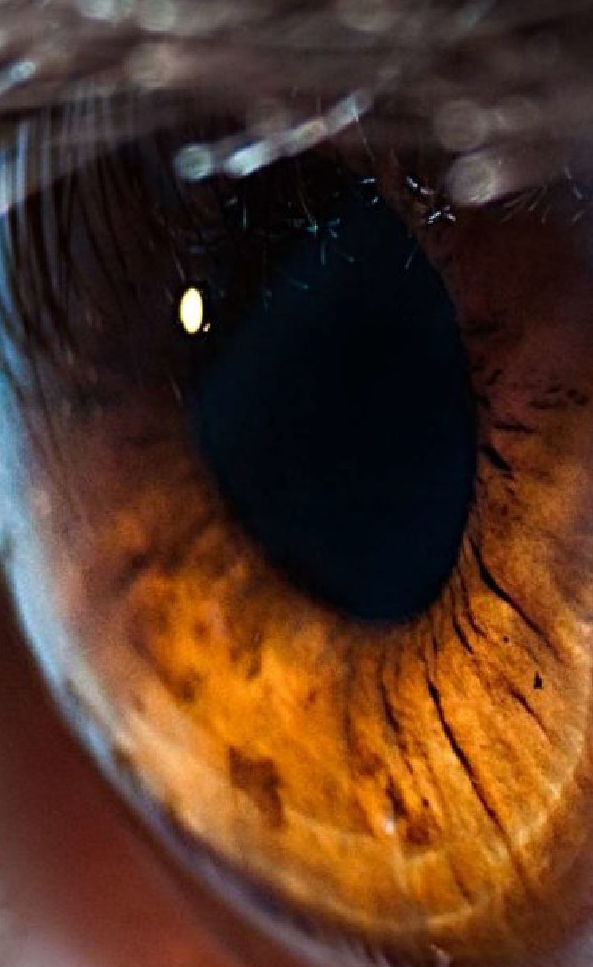
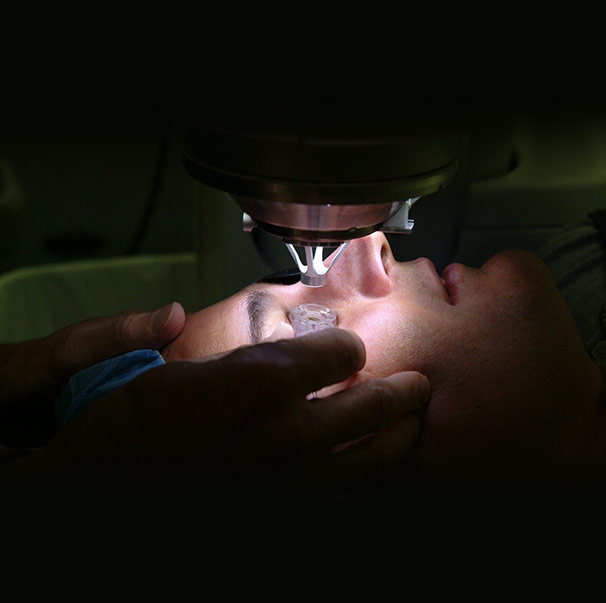
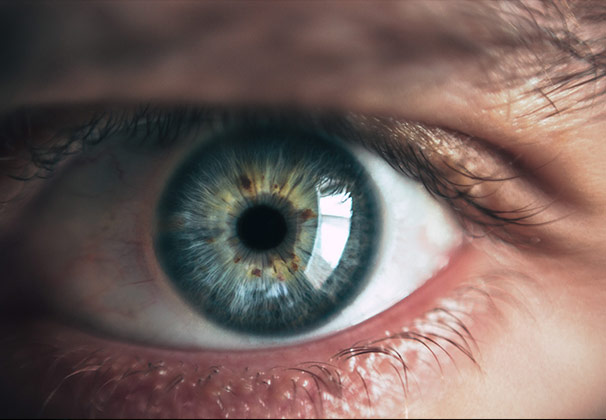
Accepted Posters
4:00 – 4:30 PM | E-Poster Viewing & Videos Online
View all e-posters and short video presentations at:
www.UofCResearchDay.com
Effectiveness of Corneal Cross-Linking in Stabilizing Corneal Topography and Visual Outcomes in Corneal Ectasia - Holdsworth M, Bhamra J
Purpose
To evaluate the long-term effectiveness of corneal collagen cross-linking (CXL) in stabilizing corneal topographic indices and visual outcomes in patients with corneal ectasia.
Methods
A retrospective chart review was conducted on 75 eyes of patients with corneal ectasia who underwent corneal cross-linking at a private ophthalmology clinic in Canada between 2018 and 2024. Timepoints included a pre-operative visit, and post-operative follow ups at 3 months, 1-year, and 2-years. Primary outcomes included autorefraction, visual acuity, and corneal topography indices. The secondary outcomes extracted were complication rates such as delayed epithelial healing, repeat CXL or corneal transplantation, and subepithelial fibrosis.
Results
At baseline, the mean spherical equivalent (SE) was –5.25 ± 4.71 D. At 1 year, SE improved modestly to –4.69 ± 3.23 D (p = 0.45), and at 2 years improved significantly to –1.20 ± 14.33 D (p = 0.024). No statistically significant changes were observed in refractive cylinder or Kmax, although Kmax trended toward flattening. Visual acuity, central corneal thickness and epithelial thickness measures remained stable across timepoints. Complication rates were low: delayed or limited epithelial healing occurred in 10% of eyes (n=8), while repeat CXL was performed in only 1% (n=1). No eyes underwent corneal transplantation following cross-linking during the study period.
Conclusions
CXL was highly effective in stabilizing corneal topography and refractive outcomes in patients with corneal ectasia in our cohort. While visual acuity and astigmatism remained stable, a significant improvement in spherical equivalent was observed at 2 years. Complication rates were low, supporting the safety and efficacy of CXL in routine clinical practice.
Why Stop at One When You Can Do Both? - Lynton Z, Al-Ani A, Rawlyk B, Kryshtalskyj M, Carrell N, Huang P, Huang P
Purpose
As demand for cataract surgery grows, rural populations in geographically vast regions like Alberta face significant access barriers. This retrospective, observational quality improvement study examines cataract surgery access for rural Albertans through a sustainability lens to guide future policy and resource planning.
Methods
Patient location (city/town and postal code) was analyzed for individuals who underwent cataract surgery between June 1, 2024, and January 30, 2025, at the Holy Cross Surgical Center in Calgary (272 patients, 450 eyes) and the Chinook Regional Hospital in Lethbridge (296 patients, 517 eyes). Surgical complexity and premium intraocular lens (IOL) selection were recorded. CO₂ emissions from travel were estimated using the myclimate calculator, assuming personal petrol car use (8.6L/100km).
Results
Patients traveled significantly farther to Calgary (mean 84.1km round trip; n = 450 procedures) than to Lethbridge (mean 72.6km; n = 517; Mann-Whitney test, p<0.0001). Travel distance did not vary by surgical complexity. Patients traveling >200km to Calgary (n = 58) were more likely to select premium IOLs compared to local patients (n = 393; Fisher’s exact test, p = 0.03), suggesting potential economic disparity in access. Universal implementation of immediately sequential bilateral cataract surgery (ISBCS) could reduce CO₂ emissions by 43.2% (~16.7 tons/year); a 36.1% opt-in rate would still achieve a 16.5% reduction (~6.15 tons/year).
Conclusion
Expanding ISBCS could significantly reduce environmental impact while improving equitable access to cataract surgery for rural populations. Continued analysis will inform evidence-based strategies for sustainable, patient-centered surgical care in Southern Alberta.
Why Stop at One When You Can Do Both?
Mapping the Temporal Dynamics of Visual Perception - Fadl A, Cone J
Understanding how brain activity decodes into visual perception and behaviour is a fundamental challenge in vision science, requiring tools that precisely measure when neuronal circuits are most critical. We developed a new approach that, for the first time, reveals the millisecond-by-millisecond relationship between visual system activity and behaviour, uncovering the dynamics of visual processing and informing the development of next-generation visual prosthetics for visual restoration and augmentation.
Methods
We used a novel “white noise” optogenetic stimulation method, delivering brief (25 ms), ultra-weak (microwatt) and randomly timed light pulses to the primary visual cortex (V1) or superior colliculus (SC) in mice performing a visual detection task. By aligning these pulses with behavioural outcomes, we generated high-resolution neuronal-behavioural kernels (NBKs) that pinpoint when perturbations in visual system activity influence perception and decision-making. An innovative framework combining machine learning algorithms and a powerful statistical analysis (Bayesian Inference) dynamically detected critical time periods of neuronal activity related to visually-guided behaviour.
Results
Our approach uncovered distinct temporal windows when V1 and SC activity most strongly influenced visual detection performance. Our statistical framework successfully tracked these dynamic effects even with behavioural variability, providing a powerful and flexible tool for studying how visual circuits shape perception.
Conclusion
This first-of-its-kind method allows unprecedented insight into the rapid and complex dynamics of visual perception and decision-making. Beyond advancing vision science, our work sets the stage for informing the future neurotechnologies to restore and augment vision by identifying when and how neuronal signals drive visual perception.
Challenges and Stakeholder Perspectives in the Referral Process for Suspected Uveal Melanoma - Laycock E, Siljedal J, Crump T, Weis E
Purpose
Uveal melanoma (UM) is a rare but deadly eye cancer with a 15-year mortality rate of 45%. Early detection is essential to improving outcomes, making timely referrals to specialists critical. The objective was to characterize the perspectives of various stakeholders involved in the referral process for suspected UM.
Methods
Using a cross-sectional mixed-method design, three stakeholders – ocular oncologists, primary eye care providers (optometrists and ophthalmologists), and patients from across North America – were surveyed and/or interviewed.
Results
Fifty-one stakeholders participated. Among 21 primary eye care providers, three felt “very confident” in differentiating between low- and high-risk lesions. Many were uncertain about where to send referrals and noted a shortage of ocular oncologists.
Eighteen ocular oncologists reported that 38% of UM cases are referred later than ideal, with 22% showing poor prognosis among initial evaluation. They also indicated that inadequate referral information led to difficulties triaging patients.
Twelve patients highlighted issues such as delayed diagnosis, and extensive travel and eye care costs.
Conclusions
The referral process for suspected uveal melanoma is complicated and obscure. The results of this study could help inform future interventions aimed at improving that process for all stakeholders.
Challenges and Stakeholder Perspectives in the Referral Process for Suspected Uveal Melanoma
Semaphorin3fa as a Proliferative Brake in the Zebrafish Retina - Shewchuk K, McFarlane S
Genetic conditions such as Leber Congenital Amaurosis disrupt retinal development and cause permanent blindness. In the embryonic retina, neurogenesis is regulated by protein signaling, but ceases in postnatal mammals. The zebrafish retina produces neurons through life partially via Müller glia (MG). Zebrafish MG produce rod precursors; and after injury, reprogram to replace lost retinal cells. MG in the mammalian retina are not neurogenic. The signaling mechanisms that regulate the neurogenic capacity of MG in the zebrafish retina are misunderstood. Here, we investigate how the signaling protein Semaphorin3fa (Sema3fa) limits MG proliferation in the healthy and injured zebrafish retina
Methods
We use a light injury model to ablate larval zebrafish photoreceptors. We use fluorescent in situ hybridization to visualize gene expression, and RT-qPCR to quantify gene expression. We use a CRISPR/Cas9 generated loss of-of-function mutant for Sema3fa to assess its function and EdU to measure proliferation.
Results
In the larval zebrafish retina sema3fa is expressed in and around MG. Sema3fa receptors are expressed in select MG, indicating that specific MG can respond to Sema3fa. We see increased proliferation (EdU+ cells) in the resting and injured Sema3fa loss-of-function retina. Through RT-qPCR, we see increased expression of proliferative genes in healthy and injured mutants.
Conclusion
Our results suggest that Sema3fa inhibits MG proliferation in the zebrafish retina. The findings from this project will help identify ways to remove brakes in endogenous stem cell pathways in the human retina that need to be therapeutically re-awakened to replace cells lost in childhood retinal diseases.
Semaphorin3fa as a Proliferative Brake in the Zebrafish Retina
Evaluating AI Diagnostic Software for Ophthalmic Clinical Practice - Chow E, Crump T, Weis E
The integration of diagnostic image analysis using artificial intelligence (AI) into clinical ophthalmology practices is advancing rapidly, promising significant improvements in diagnostic accuracy, workflow efficiency, and patient outcomes. However, the clinical implementation of these technologies varies considerably. The purpose of this study is to evaluate currently available AI-based ophthalmic software to inform practitioners about their potential for integration into routine clinical care.
Methods
This study employed a rapid review design. Searches were conducted using Crunchbase, Pitchbook, advanced Google search, and ChatGPT-based web searches. Technologies were included if they were commercially available; specifically applied to ophthalmology; and used diagnostic images. Relevant websites and supporting documentation were reviewed. The following information was systematically extracted: primary eye disorder, regulatory approval status, intended use, clinical value proposition, implementation requirements, and revenue model.
Results
Complete results of are summarized in table 1. Ten companies were identified, 90% of which were developed to identify diabetic retinopathy. Of these, 60% of which were approved by the Food & Drug Administration in the United States and 70% were approved by the Conformité Européenne representing approval within the European Union but only 30% of the companies were approved for diagnosis (vs decision support) – representing a higher threshold of clinical accuracy for regulatory approval.
Conclusion
This study demonstrates that AI-driven ophthalmic solutions are primarily focused on diabetic retinopathy. The majority of these have been approved for decision support, which may limit their value to ophthalmology clinics, where experience in diagnosing this condition is already prolific.
Evaluating AI Diagnostic Software for Ophthalmic Clinical Practice
Movement Impairments Do Not Preclude Visuomotor Adaptation After Stroke - Moore R, Piitz M, Singh N, Dukelow S, Cluff T
Proliferative vitreoretinopathy (PVR) is a leading cause of recurrent retinal detachment (RD) following surgical repair, driven by inflammatory and fibrotic processes on the retinal surface. Methotrexate (MTX), a folate antagonist with antiproliferative and anti-inflammatory properties, has emerged as a potential adjunctive therapy in PVR management. This study evaluates clinical outcomes, complications, and predictors of RD recurrence following intravitreal MTX in a Canadian cohort.Introduction: Proliferative vitreoretinopathy (PVR) is a leading cause of recurrent retinal detachment (RD) following surgical repair, driven by inflammatory and fibrotic processes on the retinal surface. Methotrexate (MTX), a folate antagonist with antiproliferative and anti-inflammatory properties, has emerged as a potential adjunctive therapy in PVR management. This study evaluates clinical outcomes, complications, and predictors of RD recurrence following intravitreal MTX in a Canadian cohort.
Methods
A retrospective chart review was conducted on 35 eyes from 35 patients who received intravitreal MTX (200-400μg/0.05-0.1mL weekly for up to 12 weeks) following pars plana vitrectomy for RD associated with, or at high risk of developing, PVR. Primary outcomes were best-corrected visual acuity (BCVA), RD recurrence, and complications. Secondary analyses assessed correlations between baseline clinical characteristics and final BCVA.
Results
Of the cohort, 22 patients (62.8%) had confirmed PVR-C, while 13 (37.1%) had milder forms of PVR and received MTX prophylactically. The median follow-up was 182 days. Recurrent RD occurred in 6 patients (17.1%). BCVA improved significantly from baseline at both 6 and 12 months (p<0.001). Baseline BCVA moderately correlated with final BCVA (ρ=0.45, p=0.010). Anterior chamber inflammation also decreased significantly over time (p<0.001). The most common complications were elevated intraocular pressure (62.9%), transient hypotony (51.4%), epiretinal membrane formation (51.4%), and corneal abrasions (25.7%).
Conclusion
Intravitreal MTX appears to be a safe adjunctive therapy that may enhance visual outcomes and reduce RD recurrence in high-risk patients with or without established PVR. Further prospective studies are warranted to refine dosing protocols and confirm long-term efficacy.
Movement Impairments Do Not Preclude Visuomotor Adaptation After Stroke
Parsing the Electrophysiological Signatures of Attention - Kazeminejad K, Ghosh S, Cone J
Purpose
Attention efficiently allocates our limited cognitive resources by prioritizing specific sensory inputs for further processing to enhance performance and speed reaction times. These behavioural changes are coupled to concurrent changes in neurophysiological processes such as enhanced responses of visual neurons, reduced influence of distracting information, and increased arousal. While these processes covary, emerging literature shows that they arise from distinct neurobiological processes. Given this, parsing the diverse neural mechanisms that support attention is critical for developing new diagnostic tools and therapeutics for attention-related disorders, ultimately improving mental health outcomes.
Methods & Results
To address, we will analyze a rich dataset of 2,525 neurons recorded in visual area V4 of two macaque monkeys while they performed a challenging visual attention task. Attention was manipulated to engage either selective or distributed attentional mechanisms, allowing us to examine interactions between attentional states, arousal, neuronal spiking, and task performance. Machine learning techniques, including Tensor Decomposition, ISOMAP, and projections onto experimenter-defined subspaces, were employed to identify low-dimensional signatures linked to attentional states.
Conclusion
By parsing how shifting between selective and distributed attention impacts neurophysiological and behavioural correlates of attention in neuronal populations and linking these low-dimensional signatures to spiking activity in visual neurons, we aim to refine our understanding of fundamental cognitive functions.
Parsing the Electrophysiological Signatures of Attention
Impairments in Visuomotor Adaptation in the First Six Months of Stroke Recovery - Alizada A, Eamon C, Moore R, Dukelow S, Cluff T
Purpose
Stroke survivors commonly engage in rehabilitation to reduce movement impairments. Visual feedback is often used by therapists to support the relearning of movements essential for daily activities. Our work has shown that strokes can disrupt the processes that support visuomotor learning in early recovery, but how these impairments evolve over the first six months remains unclear. Here, we examined impairments in visuomotor adaptation during the first six months of recovery.
Methods
Participants with first-time, unilateral stroke completed a robotic visuomotor adaptation task at four timepoints (<3-, 6-, 12-, 26-weeks post-stroke). A 30° rotation altered the relationship between the motion of the participant’s occluded arm and a hand feedback cursor displayed in their workspace. We measured the rate and amount each participant adapted to this disturbance. Normative thresholds from healthy controls, matched for overall age and sex, were used to identify impairments (performance <5th percentile).
Results
We assessed 133 controls and stroke survivors (n = 46, 24, 23, 17) across four post-stroke timepoints. At <3 weeks post-stroke, 50% of participants were impaired in visuomotor adaptation. The incidence of impairment decreased over time, with 76.5% of participants unimpaired by 26 weeks. Late adaptation impairments persisted in 17.6% of participants at 26 weeks.
Conclusion
Impairments in visuomotor adaptation are common early after stroke and persist in a subset of individuals through the first six months of recovery. Early identification of these deficits may help clinicians target impairments directly or select alternative approaches, such as explicit task instruction, to improve adaptive motor learning.
Impairments in Visuomotor Adaptation in the First Six Months of Stroke Recovery
Recurrent Haemophilus Influenzae Conjunctivitis and Corneal Scarring in a Child with X-Linked Agammaglobulinemia - Alizada A, Wright N, Dodd U
Background
X-linked agammaglobulinemia (XLA) is a rare primary immunodeficiency characterized by absent B cells and severely reduced immunoglobulin levels. Corneal scarring is an uncommon but vision-threatening complication of recurrent conjunctivitis in XLA.
Clinical Case
An 11-year-old boy with genetically confirmed XLA, maintained on regular IVIG therapy (IgG trough levels >9 g/L), presented with a 9-month history of recurrent conjunctival injection and mucopurulent discharge. Conjunctival swabs isolated Haemophilus influenzae sensitive to amoxicillin on two separate occasions. Initial management with antihistamines and topical ointments provided temporary relief. Nasolacrimal duct probing was performed but failed to resolve symptoms. A prophylactic regimen of systemic amoxicillin (250 mg twice daily) was initiated, resulting in significant reduction of conjunctivitis episodes. After three years of stable control, prophylaxis was discontinued by the patient’s family due to concerns about long-term antibiotic use. This led to the recurrence of severe bilateral conjunctivitis with green discharge, photophobia, and ocular pain. Examination revealed bilateral corneal scarring with reduced visual acuity (20/25 right eye, 20/40 left eye). Resumption of amoxicillin improved symptoms, but corneal scarring and visual impairment persisted.
Conclusion
This case highlights that IVIG therapy, while effective for preventing systemic infections in XLA, may not protect against conjunctivitis because of underlying Bruton’s tyrosine kinase dysfunction or impaired ocular immune homeostasis. Sustained prophylactic antibiotics can prevent recurrent conjunctivitis and its complications, including the rare but vision-threatening development of corneal scarring. Given this risk, patients with XLA require regular ophthalmologic monitoring, early antibiotic intervention, and long-term treatment adherence within a multidisciplinary care framework.
Non-Visual Photoreceptor Structure in the Forgotten Third Eye - Heshami N, Bertolesi G, McFarlane S
In this study, I determined the organization of cells within the pineal complex and how this organization emerges over development. I utilized the experimentally accessible Xenopus laevis model, which has a pineal complex that we find expresses multiple opsins. I studied photoreceptors that express Pinopsin and/or Melanopsin, two opsins that our lab has found play key roles in circadian regulation, the former via the pineal complex and the latter involving the eye.
We used fluorescent in situ hybridization, immunohistochemistry, and advanced imaging techniques to examine melanopsin and Pinopsin expression over larval development. We determined the cellular arrangement of photoreceptors, projection neurons, and melatonin-synthesizing cells at different developmental stages. This study sheds light on our understanding of how the cellular organization of the third eye of non-mammalian vertebrates develops. This analysis also helps us to better understand the structural and functional links between the retina and the pineal complex.
Non-Visual Photoreceptor Structure in the Forgotten Third Eye
High-Grade B Cell Lymphoma in a Child with Ataxia Telangiectasia - Wandzura A, Mandziuk J, Solarte C, Roelofs K
Purpose
We report a rare pediatric ocular adnexal high grade B cell lymphoma on a background of ataxia telangiectasia; an inherited neurodegenerative disorder that increases the risk of developing Non-Hodgkins Lymphoma up to 25%.
Methods
Case Report
A 12 year old male was referred to our hospital with a 1-week history of rapidly progressive left orbital swelling. His medical history was notable for ataxia telangiectasia, with secondary immunodeficiency and microcephaly. Best corrected visual acuity measured 20/100 OS and 20/30 OD with normal intraocular pressures OU. Ophthalmic exam revealed significant left proptosis, chemosis and minimal excursion of extraocular movements in all directions. The remainder of the exam was unremarkable. Orbital biopsy was performed via a transcaruncular approach.
Histopathology identified Burkitt’s lymphoma (BL) and high grade B-cell Lymphoma as differential possibilities (Figure 2), with additional characterization via FISH revealed 40% MYC gene rearrangement clinching the diagnosis of BL. The patient underwent 4 courses of IV and intrathecal chemotherapy (Cyclophosphamide, Vincristine, Methotrexate, Cytarabine). 6 months post-presentation he is doing well, with no evidence of metabolically active lesions on PET scan.
Conclusions
Non Hodgkin’s Lymphoma of the ocular adnexa is known to present at higher frequencies in immunocompromised patients, including ataxia telangiectasia. To the best of our knowledge, this is the first case of pediatric high-grade B cell NHL in the ocular adnexa presenting with a background of ataxia telangiectasia. This case also highlights the value of additional molecular genetic testing, which ultimately excluded the diagnosis of Burkitts lymphoma.
High-Grade B Cell Lymphoma in a Child with Ataxia Telangiectasia
Characterizing Trends in the Burden of Eye Cancer in Canada - Zuberi R, Li T, Omer M, Saini N, Weis E
Purpose
There are few studies that characterize the burden of eye cancer and trends over time. Aretrospective, descriptive epidemiological study of the Canadian population was performed to examine this.
Methods
Data on the incidence, prevalence, mortality, years lived with disability (YLDs), years of life lost(YLLs), and disability attributable life years (DALYs) for eye cancer (ICD-10 C69.0-69.8) in Canada from 1980to 2021 were derived from the Global Burden of Disease Study. Estimations were derived from cancerregistries and vital registrations. Joinpoint regression analysis was performed to evaluate the average annualpercentage change (AAPC) in each metric over time and statistically determine any inflection points. Tomeasure the economic impact of eye cancer, we estimated the value of 1 DALY at 1-3 times GDP per capita.
Results
Between 1990 and 2021, there was an absolute increase in incident cases (AAPC=1.38, CI[1.28,1,42]), prevalent cases (AAPC=1.18, CI[1.18, 1,30]), deaths (AAPC=1.24, CI[1.16, 1.30]), total YLLs(AAPC=0.61, CI[0.54, 0.68]), YLDs (AAPC=1.34, CI[1.28, 1.41], and DALYs (AAPC=0.78, CI[0.69, 0.86]) fromeye cancer. In 2021, 1673 DALYs were attributable to eye cancer, resulting in an economic burden of 88-264million USD. The average annual economic burden through this time period was 77-221 million USD.
All measures were age-adjusted and converted to rates per 100,000 people. Between 1990-2021, there was adecrease in the overall incidence (AAPC=-0.78, CI[-0.91, -0.69], prevalence (AAPC=-0.75, CI[-0.88, -0.63]),mortality (AAPC=-1.31, CI[-1.31, -1.38], YLLs (AAPC=-1.55 CI[-1.61, -1.49]), YLDs (AAPC=-0.80, CI[-0.90.-0.71]), and DALYs (AAPC=1.44, CI:[-1.53,-1.36]) (Figure 1) per capita. For all measures except YLLs, aninflection point indicated an increase in all measures from 2009-2019. A negative trend was observed from2019-2021, possibly associated with the COVID-19 pandemic.
Conclusion
As Canada’s population has grown, it has observed a growing burden of eye cancer across allmeasures under study. Per capita, Canada has seen an overall improvement in the burden of this disease.However, the results suggest that since 2009, there may be a growing burden of eye cancer, in opposition tothe prevailing trend.
Characterizing Trends in the Burden of Eye Cancer in Canada
Adjunctive Aqueous Suppressants in Anti-VEGF Therapy - Sadek K, Osman R, Tao B, Navajas E
Purpose
To critically appraise clinical evidence evaluating adjunctive usage of topical aqueous suppressants (β-blockers or carbonic anhydrase inhibitors) with intravitreal anti-VEGFs treatment for diabetic macular edema (DME), neovascular age-related macular degeneration (nAMD), and retinal vein occlusion (RVO), focusing on retinal thickness, visual acuity, treatment burden, and safety outcomes.
Methods
We performed a narrative literature review (2000–2025), identifying clinical trials, observational cohorts, and case series comparing anti-VEGF monotherapy versus anti-VEGF combined with topical aqueous suppressants. Findings were synthesized descriptively by disease group without formal meta-analysis.
Results
In DME (four small RCTs, ~100 eyes), three studies reported that adjunctive dorzolamide (± timolol) yielded 3-month CMT reductions 25–71 µm greater than anti-VEGF alone, with modest VA improvements; one contralateral-eye RCT reported no effect. In nAMD (four studies), a placebo-controlled RCT (n=52) demonstrated an additional –38 µm CST reduction at 3 months; a refractory-eye series reported similar thinning but stable acuity; and retrospective data suggested reduced injection burden 2 years with systemic β-blockers and non-significant trends toward greater CST thinning and VA gain. In RVO (two small trials, ~46 eyes), adjunct drops produced transient week-5 CRT thinning and modest CFT/CST reductions but no sustained anatomical, visual, or injection-interval benefit. Across studies, adjunctive therapy consistently lowered intraocular pressure and produced no serious adverse events.
Conclusions
Heterogeneous evidence suggests aqueous suppressants confer small, short-term anatomical benefits—particularly in DME and refractory nAMD/RVO—without consistent visual or durability improvements. Routine combined use is not recommended; well-powered prospective trials with standardized endpoints are needed to define their clinical utility.
Adjunctive Aqueous Suppressants in Anti-VEGF Therapy
Choroidal Thickness in Retinal Vein Occlusion Before and After Anti-VEGF and Steroid Injections - Sadek K, Tao B, Butt F, Yu P, Yan P
Purpose
To evaluate associations between different intravitreal treatments and changes in choroidal thickness and visual acuity in patients with retinal vein occlusion (RVO).
Methods
We searched Cochrane Central, MEDLINE Ovid, and Embase Ovid for prospective and retrospective studies involving central or branch RVO treated with intravitreal anti-VEGF or corticosteroids. Primary outcomes were subfoveal choroidal thickness (SFCT) and best corrected visual acuity (BCVA) changes from baseline at 1, 3, 6, and 12 months. Two independent reviewers selected studies, extracted data, and assessed quality.
Results
Of 2,449 studies, 27 (1,587 eyes) met inclusion criteria. At 1 month, SFCT significantly decreased with bevacizumab (-25.80 µm, p<0.01) and dexamethasone (-17.59 µm, p=0.05), but not with ranibizumab, triamcinolone, or aflibercept. BCVA significantly improved at 1 month with dexamethasone (-0.20, p<0.01) and bevacizumab (-0.10, p=0.01). At 3 months, SFCT reduction persisted with bevacizumab (-32.27 µm, p=0.01) and dexamethasone (p=0.03), although BCVA improvements were not significant. At 6 months, only bevacizumab demonstrated continued SFCT reduction (-37.00 µm, p<0.01) and significant BCVA improvement. By 12 months, neither bevacizumab nor ranibizumab significantly affected SFCT.
Conclusions
In patients receiving intravitreal therapy for RVO, bevacizumab was associated with sustained SFCT reduction and periodic BCVA improvements up to 6 months, while dexamethasone showed shorter-term SFCT reductions. These findings may inform treatment selection and timing in clinical practice. Further studies are needed to clarify long-term effects.
Choroidal Thickness in Retinal Vein Occlusion Before and After Anti-VEGF and Steroid Injections
Epidemic Group A Streptococcus: Periocular Necrotizing Fasciitis - Kryshtalskyj M, Schell C, Lee-Wing M, Morin J, Morgenstern K, Burkat C, Byers B, Punja K
Purpose
Jurisdictions across North America have reported a recent epidemic of GAS infections, with rates increasing by up to 77% since 2022.1,2 We report a multicentre series of aggressive, periocular necrotizing fasciitis (NF), and the diverse techniques used to debride and reconstruct.Purpose: Jurisdictions across North America have reported a recent epidemic of GAS infections, with rates increasing by up to 77% since 2022.1,2 We report a multicentre series of aggressive, periocular necrotizing fasciitis (NF), and the diverse techniques used to debride and reconstruct.
Study Design: Case series.
Methods
Charts of patients with periocular necrotizing fasciitis between 2022-2025 were reviewed. Written consent for patient information to be collected was obtained. Approval was waived from the University of Calgary Conjoint Health Research Ethics Board.
Results
19 patients were identified. Ages ranged from 4-69 years (median 55.5 years), and 16 (84%) were male. 7 (37%) had concurrent substance use, 6 (32%) had diabetes, 2 (11%) were immunocompromised, and 4 (21%) were healthy. Distribution of NF included preseptal upper eyelid (100%), preseptal lower eyelid (9, 47%), posterior upper and lower eyelids in 2 cases, and orbital in 2 cases. 5 (26%) cases were bilateral. Regional or distant infected wounds (forehead, palate and nasopharynx, 5th finger) were associated in 3 cases, and extensive metastatic NF was observed in 1 delayed presentation (occiput, neck, leg, and scrotum). 5 cases were associated with fasciitis tracking down the neck via co-planar superficial temporal fascia. A conservative, skin-sparing debridement was attempted in 10 cases (53%). 100% of cases grew GAS, and 5 cases were polymicrobial (commonly with Staphylococcus aureus). Coronavirus-19 or influenza tested positive in 2 patients. Reconstructions included skin grafting in 7 cases (37%) and delayed primary closure in 5 cases (26%). 2 bare-bone defects were addressed using a temporalis turnover flap and biodegradable temporizing matrix prior to skin grafting. 1 case received a paramedian forehead flap. 1 case with full-thickness necrosis of the upper and lower eyelids received a periosteal flap and contralateral free tarsal graft to reconstruct posterior lamellar support, a forehead rotation flap, and bladder matrix to temporize. 1 case required enucleation for an ischemic, necrotic globe. Amniotic membrane was used in 1 case. 4 patients received negative pressure wound therapy to promote granulation before reconstruction, and 1 patient received hyperbaric oxygen. 3 patients received steroids after infection had cleared. Considering initial defects, outcomes were reasonable at median follow-up (4 months, range 0.5-12 months). Major complications included exposure keratopathy (n=1), skin graft failure (n=1), superonasal pedicle loss (n=1), and death in the 1 case with metastatic NF. Mild lagophthalmos was seen in 4 patients.
Conclusion
This series illustrates the diversity and complexity of NF presentations and the wide array of approaches used by different surgeons to debride and reconstruct. With GAS on the rise worldwide, providers should remain vigilant for periocular NF and treat it early and aggressively with tissue- and globe-sparing approaches.
Epidemic Group A Streptococcus: Periocular Necrotizing Fasciitis
Orbital Asymmetry in Children with Congenital Ptosis - Kryshtalskyj M, Morgenstern K, Burkat C, Punja K
Purpose
Congenital ptosis is a condition attributed to dysgenesis of the levator palpebrae superioris. Here, we report orbital asymmetry associated with congenital ptosis.
Study Design Prospective observational study.
Methods
19 consecutive patients with congenital ptosis were enrolled. Demographic data and associated ophthalmic and orbital conditions were documented. Exophthalmometry was performed by 2 independent observers, and average inter-eye differences were calculated. Measurements were obtained upright in clinic, or for younger children, under general anaesthetic at the time of ptosis surgery. Where cooperation permitted, axial length was measured using optical biometry. REB approval was obtained.
Results
19 patients were enrolled from November 2023 to April 2025. 11 patients (58%) were female. Average age was 6.7 ± 6.3 years (range 7 months to 23 years). The right eye was more ptotic in 10 cases (53%). 4 cases (22%) were bilateral. Associated conditions were observed in 9 patients (47%), and were all encountered on the more ptotic side. These included NLDO (n=3), superotemporal orbital dermoid cysts (n=3), and Marcus-Gunn jaw wink (n=3). Blepharoptosis-phimosis epicanthus inversus syndrome (n=1) was seen in 1 patient. Exophthalmometry consistently demonstrated relative enophthalmos on the more ptotic side (n=18, 95%), with an average of -1.23 ± 0.54 mm of inter-eye difference (p<0.001, t-test). Relative enophthalmos was independent of differences in axial length (R2 = -0.02, p=0.41) or age (R2 = 0.03, p=0.45) by multiple linear regression. For the more ptotic side, average difference in axial length was -0.14 ± 0.38 mm between eyes, which was not significant (p=0.29, t-test).
Conclusion
Congenital ptosis was reliably associated with relative enophthalmos independent of globe size, and a high incidence of other orbital conditions. In addition to another Calgary study demonstrating other tissues involved in this condition (e.g. Muller’s muscle),2 and facial asymmetries previously reported in association with congenital ptosis,1 these results suggest that deficits in orbital volume, or other processes in orbital embryogenesis, may also be implicated in this condition.
Orbital Asymmetry in Children with Congenital Ptosis
Precision Eye Tracking Reveals Saccadic Dysfunction Post-Stroke - Kuhl L, Chilvers M, Poitras I, Hill A, Dukelow S
Purpose
Making quick and accurate saccades are crucial to the thousands of eye movements we make each day. Oculomotor deficits are prevalent post-stroke, yet clinical assessments of saccades are crude. Creating more sensitive and robust assessments for eye movements poststroke is important for improving rehabilitation outcomes. Here, we aimed to characterize and assess saccades to visual targets in stroke survivors in the subacute phase of stroke. Methods: We assessed saccades to visual targets in 52 stroke survivors (median 25 days post-stroke) and
109 control participants using a Kinarm robotic exoskeleton and an Eyelink 1000 eye tracker. In the visual saccade task, participants fixated on a central visual target and made saccades (10cm horizontally) to peripheral visual targets. We measured accuracy, latency, and peak velocity of the first saccade made after the central visual target turned off, as well as the accuracy of the closest saccade made to the peripheral target (corrective accuracy). Age-, sex-, and handednessadjusted z-scores were created for stroke participants using control data to generate normative models.
Results
Stroke survivors had impairments in visual saccade accuracy (38% impaired), latency (21%), and peak velocity (19%). Additionally, 48% of stroke survivors had abnormal corrective accuracy. However, only 15% of stroke survivors were diagnosed with eye movement problems during their hospital stay.
Conclusions
Many stroke survivors had impaired saccades to visual targets despite no clinical diagnosis of eye movement issues. Understanding the prevalence and characteristics of saccadic deficits post-stroke may help inform how we design and deliver stroke rehabilitation.
Precision Eye Tracking Reveals Saccadic Dysfunction Post-Stroke

